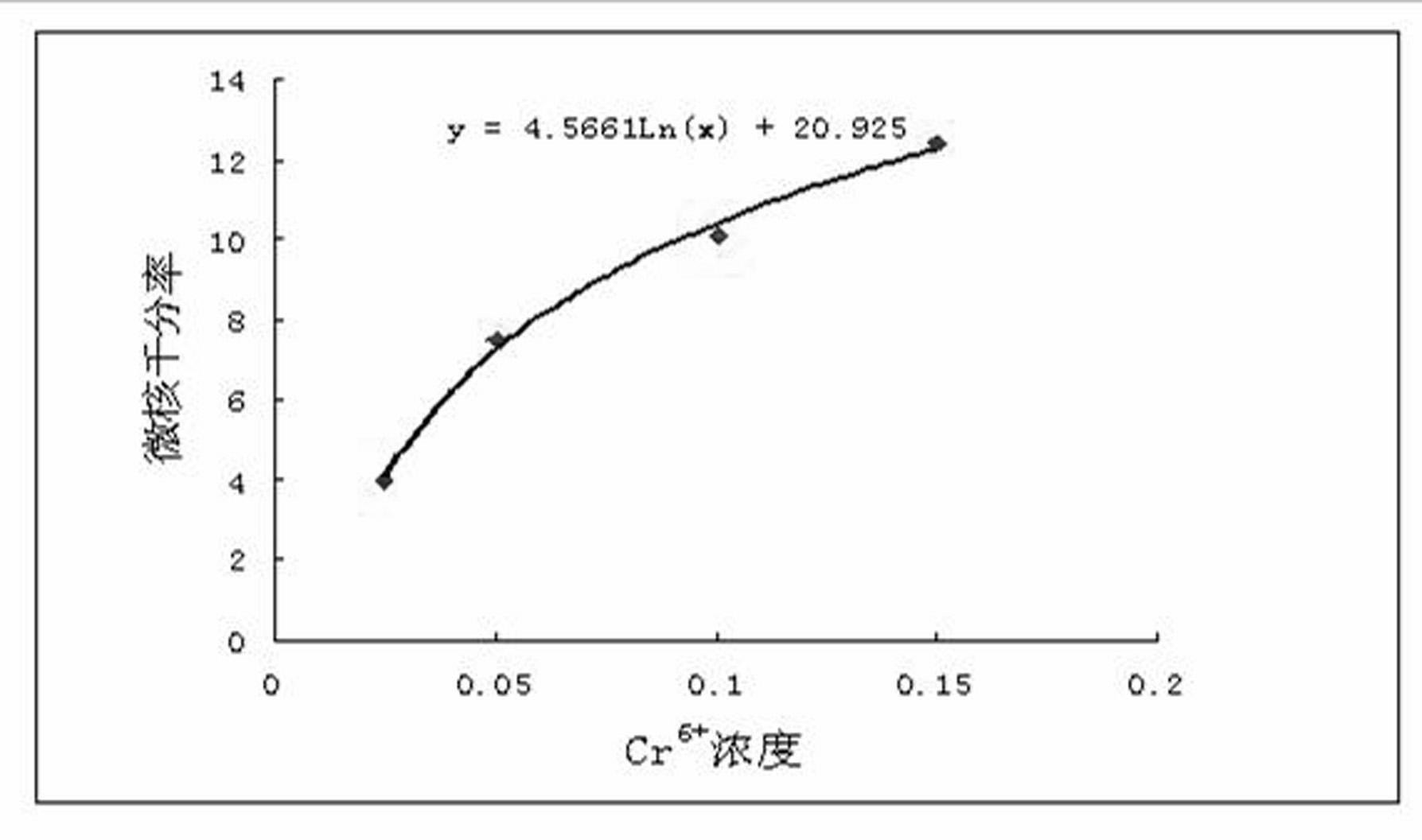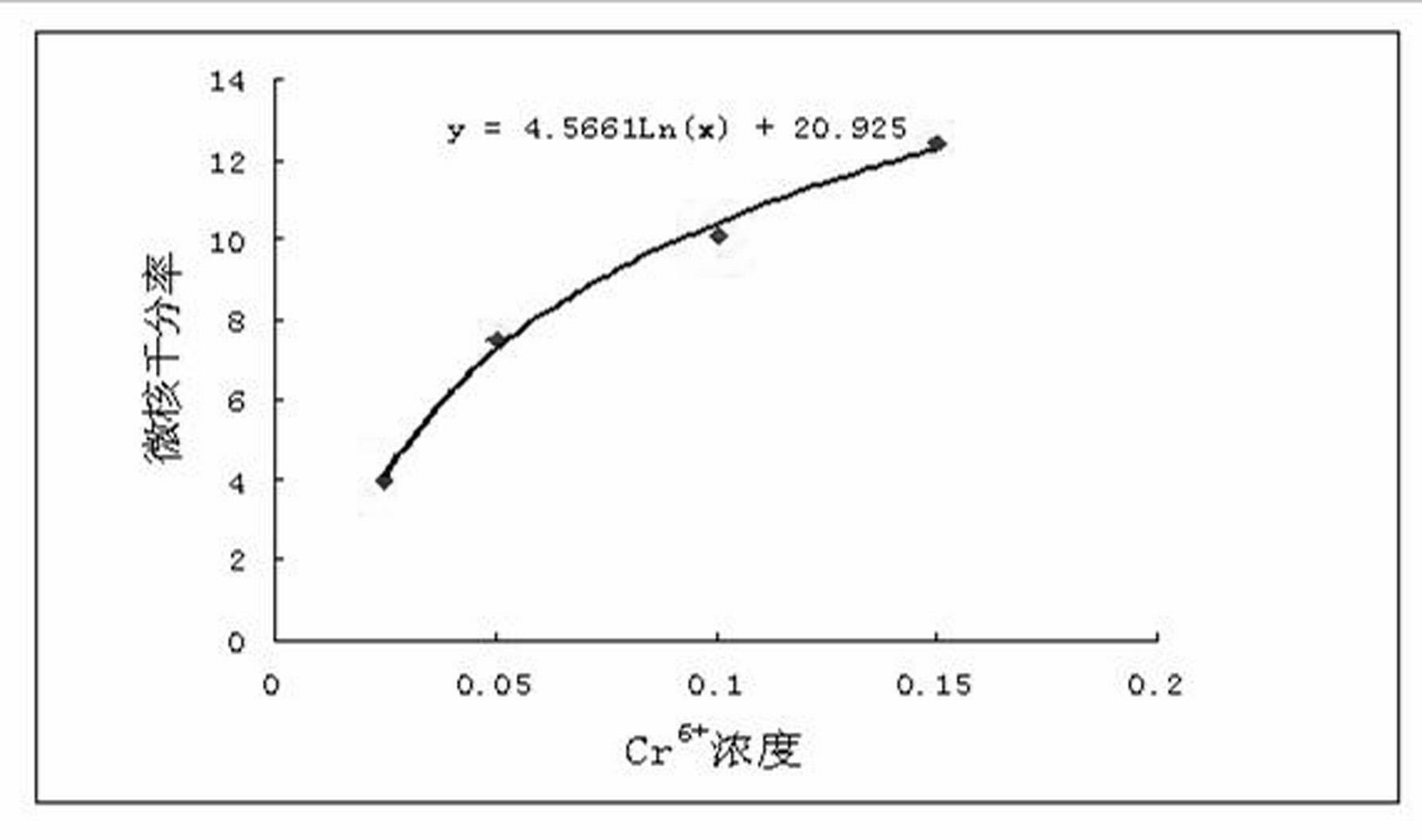Method for detecting water quality genetic toxicity by broad bean root tip micronucleus test
A micronucleus test and root tip technology is applied in the field of water quality genotoxicity detection by broad bean root tip micronucleus test, which can solve the problem of invisibility of toxicity reaction, and achieve the effects of intuitive detection results, easy unification of detection results, and accurate water quality toxicity.
- Summary
- Abstract
- Description
- Claims
- Application Information
AI Technical Summary
Problems solved by technology
Method used
Image
Examples
Embodiment 1
[0024] This specific embodiment adopts the following steps:
[0025] (1) Choose Songzi green skin beans as indicator creatures;
[0026] (2) After soaking seeds for 24h and accelerating germination for 60h, after the primary roots of the seeds grow to 1.5cm, 6+ Take 5 concentration points in the range of 0-0.015mg / L to treat the root tip for 6 hours respectively. The Cr concentration of these 5 concentration points 6+ The concentrations are respectively 0mg / L, 0.025mg / L, 0.05mg / L, 0.1mg / L, 0.15mg / L; after soaking and washing the treated seeds with deionized water, the root tip cells are repaired for 24 hours, and then the root tip A 1cm root was cut from the tip, fixed with Carnot's fixative for 24h, and finally stained with Fulgen staining method for 5h, then the root tip cells were examined under a biological microscope, Cr 6+ The cell micronucleus per thousand percentages obtained from small to large concentrations are 0.25‰, 4.25‰, 7.75‰, 10.33‰, 12.67‰;
[0027] (3) With Cr 6+ T...
Embodiment 2
[0030] This specific embodiment adopts the following steps:
[0031] (1) Choose Songzi green skin beans as indicator creatures;
[0032] (2) After soaking seeds for 36h and accelerating germination for 48h, after the primary roots of the seeds grow to 2cm, 6+ Take 5 concentration points within the range of 0-0.015mg / L to treat the root tip for 5h respectively, and the Cr of these 5 concentration points 6+ The concentrations were 0mg / L, 0.025mg / L, 0.05mg / L, 0.1mg / L, 0.15mg / L; the treated seeds were soaked and washed with deionized water to repair the root tip cells for 22 hours, and then the root tip Cut 1cm roots from the tip and fix them with Carnot's fixative for 48h. Finally, after staining with Fulgen staining method for 6h, the root tip cells are examined under a biological microscope. 6+ The cell micronucleus per thousand fractions obtained from small to large concentrations are 0.25‰, 4.26‰, 7.78‰, 10.38‰, 12.70‰;
[0033] (3) With Cr 6+ The concentration is the abscissa, the ...
Embodiment 3
[0036] This specific embodiment adopts the following steps:
[0037] (1) Choose Songzi green skin beans as indicator creatures;
[0038] (2) After soaking seeds for 24h and accelerating germination for 50-72h, after the primary roots of the seeds grow to 1.5cm, 6+ Take 5 concentration points in the range of 0-0.015mg / L to treat the root tip for 6 hours respectively. The Cr concentration of these 5 concentration points 6+ The concentrations are respectively 0mg / L, 0.025mg / L, 0.05mg / L, 0.1mg / L, 0.15mg / L; after soaking and washing the treated seeds with deionized water, the root tip cells are repaired for 24 hours, and then the root tip A 1cm root was cut from the tip, fixed with Carnot's fixative for 24h, and finally stained with Fulgen staining method for 5h, then the root tip cells were examined under a biological microscope, Cr 6+ The cell micronucleus per thousand percentages obtained from small to large concentrations are 0.25‰, 4.26‰, 7.77‰, 10.35‰, 12.69‰;
[0039] (3) With Cr 6...
PUM
 Login to View More
Login to View More Abstract
Description
Claims
Application Information
 Login to View More
Login to View More - R&D
- Intellectual Property
- Life Sciences
- Materials
- Tech Scout
- Unparalleled Data Quality
- Higher Quality Content
- 60% Fewer Hallucinations
Browse by: Latest US Patents, China's latest patents, Technical Efficacy Thesaurus, Application Domain, Technology Topic, Popular Technical Reports.
© 2025 PatSnap. All rights reserved.Legal|Privacy policy|Modern Slavery Act Transparency Statement|Sitemap|About US| Contact US: help@patsnap.com


